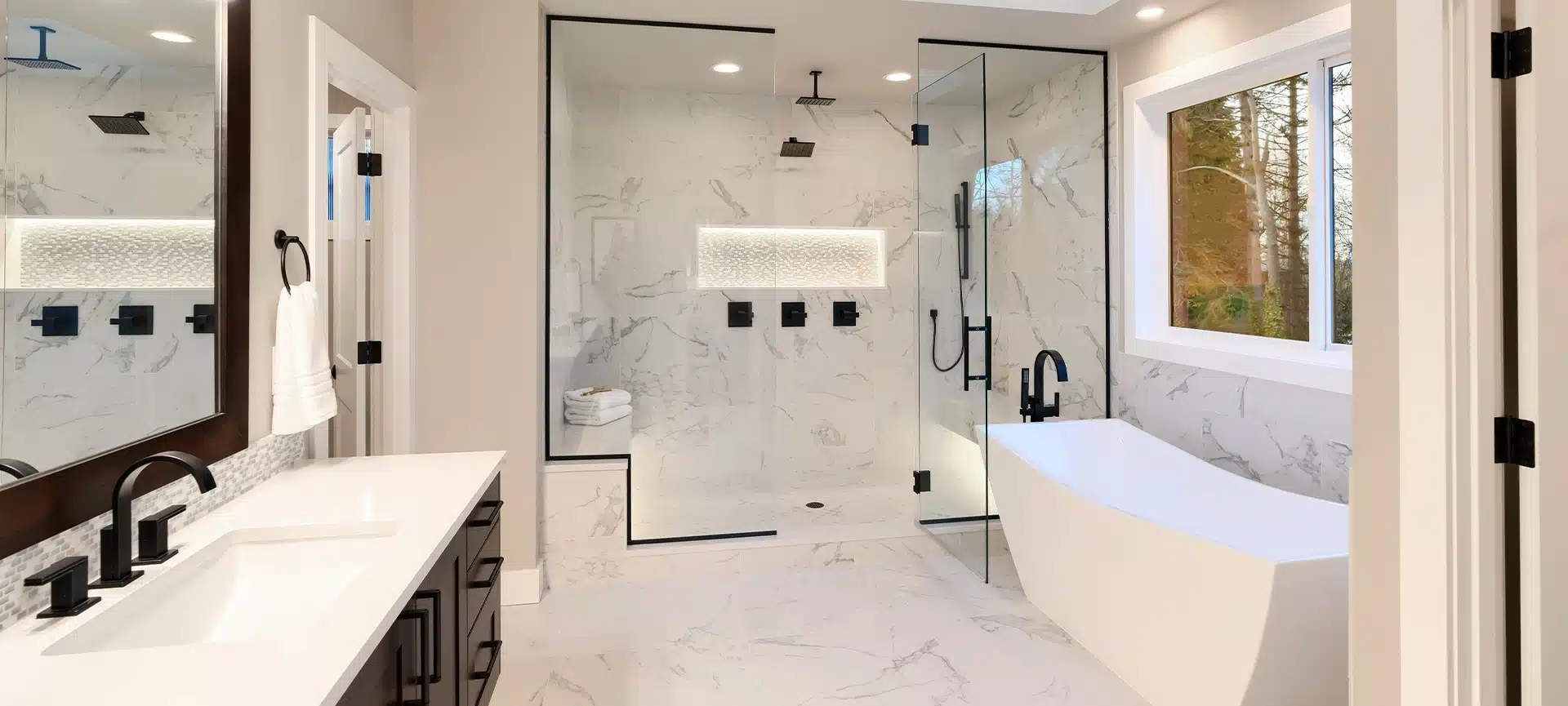Home Planning & Renovations
Ceramic vs. Porcelain Tiles: The Comparison Guide
By Tiffany Smolick
February 4, 2023
Porcelain and ceramic tiles look almost identical, can serve the same purpose, and have many applications. Many homeowners would see the two materials as similar, yet notable differences exist between them.
If you’re decorating or renovating, and you’re split between choosing one or the other, don’t fret; we’re here to help.
This article will underline the differences between porcelain and ceramic tiles, their main benefits and disadvantages, and see which surface would serve you better depending on your project.
Differences Between Ceramic vs. Porcelain Tiles
As we said, appearance-wise, both materials are almost identical. Both tiles are made in a similar process and can be used for similar purposes during flooring or bathroom renovation work. But some unnoticeable variances can make all the difference.
For starters, a porcelain tile is more durable than a ceramic one. I owe partly this to the material they are built from and partly to the process. Ceramic tiles are typically fired at 900 degrees C. Porcelain tile is made from porcelain clay which includes kaolin. It is fired at a very high temperature between 1,200 and 1,400 °C (2,200 and 2,600 °F).
Ceramic tiles are produced from a softer material like red and brown clay, which is why they are not as dense and, therefore, not as robust as porcelain tiles. The latter is made from white clay and naturally occurring minerals like feldspar, alongside quartz, calcium, and limestone, among other raw materials.
The composition of the porcelain tile makes it stronger and more resistant to water absorption, making it a better bathroom tile.
How to Tell Porcelain Tiles From Ceramic Tiles
To tell the two apart, we’ve gathered a few tips. Here is how you can differentiate between the two.
- Weight: You will often find porcelain tiles classified under the ceramic label, as they fall into the ceramic category. Ceramic and porcelain tiles can both feature a glazed or unglazed surface that makes them hard to distinguish. But being built from stronger material, a porcelain tile tends to be notably heavier than a ceramic tile.
- Color: Unglazed porcelain tiles would have a matching color when broken or otherwise damaged. Ceramic tiles frequently have a glazed surface that, if broken or damaged, will show a color difference.
- Texture: Unglazed porcelain tends to be much smoother and has a velvety surface compared to the rougher feel of an unglazed ceramic tile.
Porcelain Tiles Pros & Cons
Here are the main benefits and disadvantages of porcelain tiles.
Porcelain Tiles Pros
Durability – Porcelain is more durable and can endure higher temperatures (heat resistance) than ceramic. The resistance to heat, water, scratches, and other forms of damage increases the longevity of porcelain tiles.
Water resistance – Porcelain tiles have notably better water resistance than ceramic tiles. As noted, their composition is denser and smoother, which makes them more resilient to water absorption.
Cleaning and Maintenance – Due to their smoother surface and durability properties, porcelain tiles are easier to rinse, sweep, mop up, or otherwise clean without damaging or scratching the surface.
Porcelain Tiles Cons
Cost – This applies to both purchase and installation costs. But it works both ways, i.e., you can see the higher price as an indicator of quality; porcelain tiles are certainly of better quality than ceramic tiles.
Installation – Apart from installation costs, porcelain’s denser and more robust composition makes it harder to cut and shape. Grout – the adhesive that seals the tiles – is another element you need to factor in. To maximize the porcelain’s durability, you need to have grout of matching quality. This adhesive is also harder to clean compared to the tile itself.
Ceramic Tiles Pros & Cons
Below are just a few of the benefits and disadvantages of using ceramic tiles.
Ceramic Tiles Pros
Cost efficient – Due to being cheaper, ceramic tiles prove an affordable option for people in need of large quantities and those working on big projects but on a budget.
Easier to install – Even people with basic knowledge of tile installation can cut and shape ceramic tiles with snap cutters or tile saws and do the installation themselves. This links up with the benefit of cost efficiency, saving you money on installation.
Ceramic Tiles Cons
Weight – While lighter than porcelain tiles, using ceramic tiles, particularly for flooring purposes, can be tricky. You should have no problem installing them on a first-floor or a basement, but for second-floor or roof usage, ensure those floors are strong enough to take the weight.
Not as durable – The lower density of the ceramic tile makes it more prone to cracking and chipping and, compared to porcelain, may have a shorter lifespan.
Water absorption – Ceramic tiles absorb more than 0.5% water, while porcelain tiles less than 0.5%. This, paired with the weaker heat resistance, make ceramic tiles less durable.
Ceramic vs. Porcelain Tiles Cost
Porcelain costs more to make, hence the expected higher price for these tiles. The extra effort, however, that goes into the production of porcelain will pay over time with increased durability, water and scratch resistance, and maintenance.
The exact cost depends on specifications like how many square feet of floor/wall you want to cover and where you are. For instance, porcelain tiles for home renovation in NYC may differ from home renovation in Chicago or Boston.
Ceramic can cost about 50% less or more than porcelain. Ceramic tiles go between $0.50 and $35 per square foot, compared to the $3 to $35 per square foot for porcelain. Factoring in installation (labor) and material, the project can cost you anywhere between $800 to over $3,000.
Ceramic vs. Porcelain Tiles Applications
You can use ceramic and porcelain tiles for identical purposes. But depending on your needs, one may be more favorable than the other.
Ceramic vs. Porcelain Tiles for Bathroom
Ceramic can be a solid option for your base bathroom floor, but only if you steer clear from soaking it wet. If the ceramic tile features a quality glazing layer, it should prove a viable option for your bathroom. Otherwise, porcelain is universally acknowledged as a better option for bathroom flooring.
Ceramic vs. Porcelain Tiles for Shower
The better water/moisture resistance and density of porcelain make it an undoubtedly better option for areas frequently exposed to a lot of moisture and water, like the shower.
Ceramic vs. Porcelain Tiles for Flooring
For many, porcelain wins the porcelain vs. ceramic tile flooring debate. It works as a better, more resilient alternative to the more inexpensive ceramic. It can find applications anywhere, from soaked shower floors to heavily frequented areas like the kitchen or hallways. It is also easier to maintain.
FAQ
Which is better, porcelain or ceramic tiles?
Ceramic tiles will fit the bill if you are on a budget or looking for more design variations. If money is no object, porcelain is the recommended choice as it is denser, more durable, and more resistant to moisture and damage.
Which is more expensive, ceramic or porcelain tile?
Porcelain tiles are more expensive and can cost double the price of ceramic tiles. Plus, porcelain has a harder composition and is more difficult to work with, raising installation costs.
Which tiles are better for flooring?
Porcelain is a better flooring option, particularly for your bathroom. But it can work for your kitchen, dining room, patio, and other areas prone to spillage.
Porcelain vs. ceramic tile: which is better in a bathroom?
The better water and moisture resistance of porcelain makes it the better choice for your bathroom floor.
What are the pros and cons of porcelain tile?
Longevity, water resistance, and durability are the main benefits of porcelain tiles. However, they are pricier, cost more for installation, and are heavier, denser, and more difficult to cut.
At our NYC kitchen and bath showroom, you will find everything you need for your kitchen improvement project. If you’re ready to renovate your NYC kitchen, we’re happy to help you through the process! Contact us and get your kitchen remodeled!


